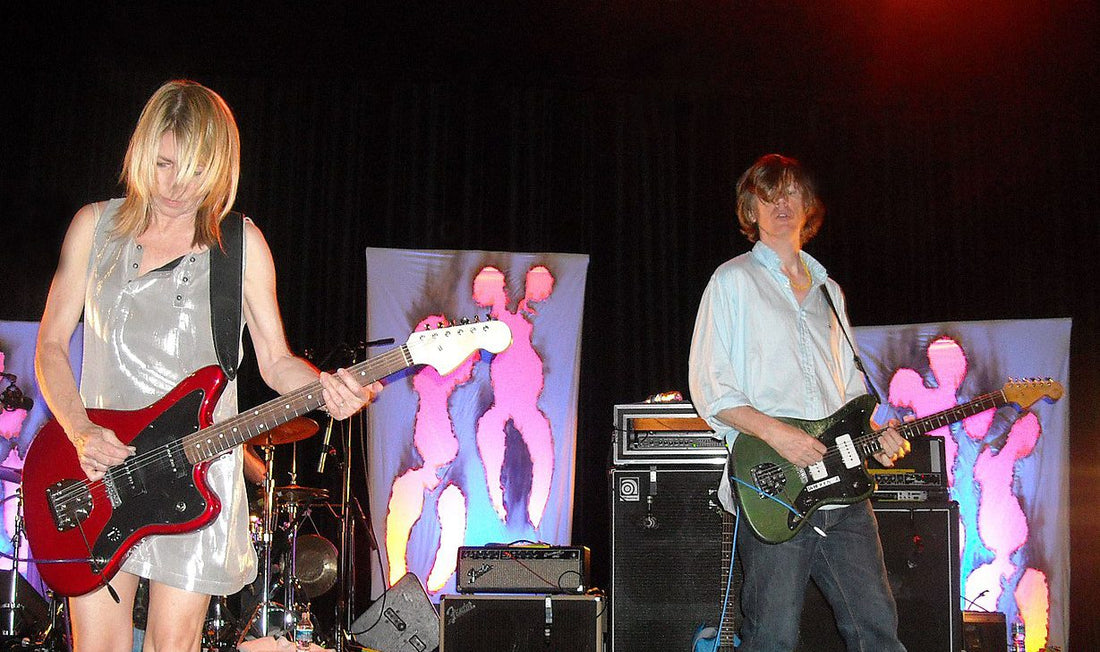They never had a Top 10 album, but Sonic Youth amassed legions of devoted fans during its nearly three decades together. That makes them an ideal subject for Off the Charts, as a band that enjoyed steady popularity and influence while staying just this side of superstardom.
In 1977, when he was 19, aspiring guitarist and songwriter Thurston Moore left his family home in Connecticut and moved to New York City to join the punk scene there. Soon he met punk singer Kim Gordon, and the two of them started a band. They changed their name every few months; by the time they’d settled on Sonic Youth, the couple had moved in together. They recruited guitarist Lee Ranaldo and took turns playing drums at gigs. Eventually they gave the drumming job to Richard Edson.
Ranaldo’s former bandmate Glenn Branca, who happened to be starting a label called Neutral Records, jumped at the chance to sign Sonic Youth as one of his first artists. His vision was to assist the more experimental side of the post-punk movement, particularly noise rock. The band’s first LP, Confusion Is Sex (1983), certainly fits the bill. Their sound was sometimes referred to as “no wave,” a dissonant, atonal reaction to the tropes of first-generation punk.
All the songs on the debut are by either Gordon or Moore, except for a cover of the Stooges’ “I Wanna Be Your Dog.” Edson left to pursue an acting career, so most of the drumming is done by Jim Sclavunos. However, Bob Bert, who would stay with the band for a couple of years, played drums on “Making the Nature Scene.” This is one of Gordon’s songs, a cry of resistance against society’s systemic disunity. She doesn’t sing, but calls the lines out in a single, clear pitch while the instruments grumble and rage in support.
The second album, Bad Moon Rising (1985), was named after the Creedence Clearwater Revival song from 1969 – choice irony, since that song is not covered on the album. However, the track list does include a song by Moore and no-wave poet Lydia Lunch called “Death Valley ’69.” (Lunch would later collaborate with Robert Smith of The Cure.) Sonic Youth experimented on this album with using what you might call connective tissue between songs.
Moore’s “I’m Insane” is one of many tracks focused on psychological darkness in American life. The distorted guitar effects, acting as a long intro to this seven-minute piece, are grounded only by Bert’s primitive thuds on the drum. Again the lyrics are spoken instead of sung, although Moore uses a more off-hand style that swoops downward every couple of words.
EVOL came out in 1986, the band’s first release on California indie label SST Records. That wasn’t the only change ushered in with this album. Steve Shelley replaced Bob Bert on drums, and Moore, Gordon, and Ranaldo began trying out a more accessible sound.
Take Gordon’s “Shadow of a Doubt,” which she whispers over a decidedly tonal and surprisingly delicate collection of plucked strings and light percussion. It deepens into stress and noise at 1:45, but quickly comes back under control.
That tendency toward pop-friendliness continued with Sister (1987); by the time Daydream Nation came out in 1988, the band had really found its new identity. Critics loved this two-disc album, and fans agreed, rewarding it with two fairly successful singles, “Teen Age Riot” and “Silver Rocket.”
This is not to say that Sonic Youth lost its edge or experimental vibe. “The Wonder” is the first part of a set of songs called “Trilogy,” which ends the album, co-written by Gordon and Moore. The LA-based crime fiction of James Ellroy inspired the title and texture of this song. Under the guitar distortion and harsh dissonances, the underlying chord progressions are more tonally based than earlier works, and Moore and Gordon are actually singing, sometimes even in harmony with each other.
Sonic Youth’s most successful album was Goo (1990), whose single “Kool Thing” made it all the way to No. 7 on the alt-rock charts. Of course, this was the era of grunge, which owed a lot to the sonics and attitude of no-wave and other post-punk movements. The band, now with the Geffen-owned DGC label, had that muddy guitar sound in mind when it recorded the album Dirty (1992). Although only one of the singles, “100%,” charted well, they did land a tour with young upstarts Nirvana the following year.
Bruce Vig, producer of Nirvana’s blockbuster Nevermind, was hired to produce the 1994 Sonic Youth album Experimental Jet Set, Trash and No Star. The wager worked, and the album captured the No. 34 spot, the highest for the band up to that point.
From that album, “Winner’s Blue” laments the things that fame steals from a person’s life. You can hear the influence of Nirvana’s Kurt Cobain in this lyrical melody accompanied on acoustic guitar. This song is unrecognizable as Sonic Youth.
The band members built their own studio after a wildly successful appearance at Lollapalooza in 1995. A Thousand Leaves (1998) was the first album to be recorded there. Critics complained about the balance and Gordon’s voice. As you can hear on “The Ineffable Me,” she employs a diaphanous style, floating around the angular melody. Note that the harmony backs away from pop accessibility. (Warning: Explicit lyrics.)
Sonic Youth continued into its third decade and the new century, putting out a studio album every two years. They might have gone on until today, but the core relationship of Moore and Gordon began to disintegrate. The Eternal (2009) turned out to be Sonic Youth’s final album. Moore and Gordon ended their marriage in 2011. Although Ranaldo held out hope for a band reunion, it never happened.
Nevertheless, they went out on top, with The Eternal reaching the No. 18 spot, their strongest sales ever. The three original members were still on board, plus Shelley on drums and Mark Ibold on bass. And unlike the last studio gasps of many long-lasting bands, this album is a solid piece of work that pleased the critics.
Moore, Gordon, and Ranaldo shared credit for “Poison Arrow” on that farewell. The most notable difference from their early years is that the dissonance and distortion are now presented in a more diffused, softened sound palette. Moore seems to be channeling Lou Reed’s somber, half-sung style, as if he’s reaching back to his proto-punk roots.



